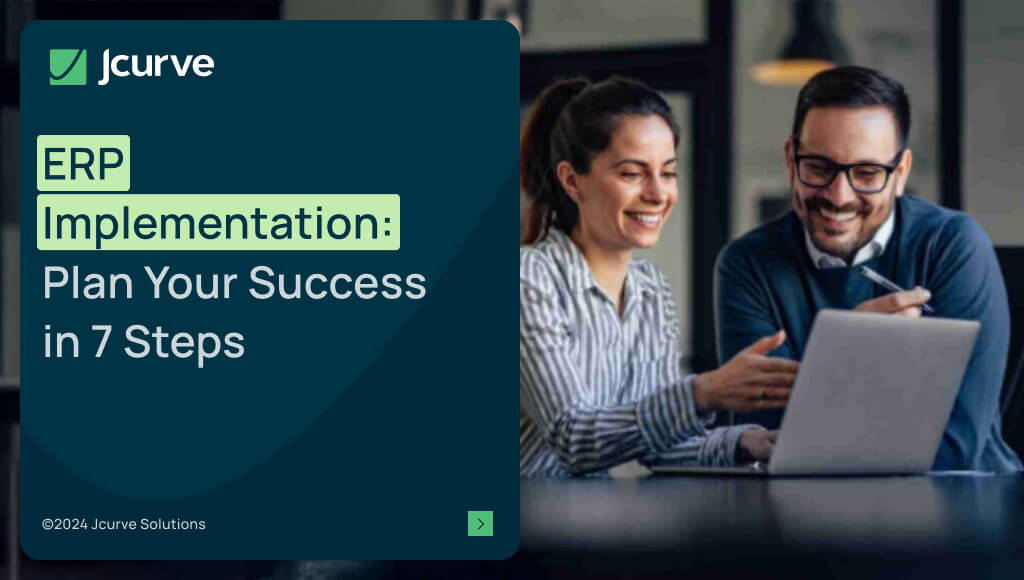
ระบบ ERP ทำหน้าที่เสมือนสมองทางเทคโนโลยีของการดำเนินงานของบริษัท ระบบนี้สามารถประมวลผลข้อมูลจำนวนมหาศาลเกี่ยวกับกิจกรรมประจำวันของธุรกิจ ระบบ ERP ให้ข้อมูลตอบกลับที่มีค่าแก่ทุกด้านของธุรกิจ และให้ข่าวกรองเกี่ยวกับทุกอย่างตั้งแต่การเคลื่อนไหวของสต็อก การคาดการณ์ความต้องการ ไปจนถึงกิจกรรมการขายและการตลาด, การซื้อของ, การบัญชี และอื่นๆ
การติดตั้งระบบ ERP ที่เหมาะสม
สามารถช่วยให้คุณได้ลูกค้าเพิ่มขึ้น รักษาความสามารถในการแข่งขัน ลดค่าใช้จ่ายในการดำเนินงาน และปรับปรุงผลการดำเนินธุรกิจ หลังจากที่ได้ตัดสินใจที่จะดำเนินการติดตั้งระบบ ERP การรับประกันความสำเร็จของโครงการจึงกลายเป็นความสำคัญสูงสุด นี่คือแผนการดำเนินการติดตั้ง ERP 7 ขั้นตอนที่จะช่วยให้คุณเพิ่มประสิทธิภาพและเห็นผลตอบแทนที่สูงขึ้นจากการลงทุนของคุณ
- รู้ว่าคุณต้องการบรรลุอะไร
หลายคนที่กำลังพิจารณาการดำเนินการติดตั้งระบบ ERP ใหม่ทำเช่นนั้นเพราะพวกเขาเห็นกระบวนการที่ไม่มีประสิทธิภาพและใช้เวลานานเข้ามาในธุรกิจ คนอื่นๆ อาจจะกำลังมีปัญหาในการได้รับข้อมูลที่แม่นยำและทันเวลาซึ่งพวกเขาต้องการเพื่อทำการตัดสินใจทางธุรกิจที่ว่องไว
การจดบันทึกรายการของผลลัพธ์ที่รวดเร็วและการปรับปรุงในระยะยาวที่คุณต้องการเห็นนั้นเป็นจุดเริ่มต้นที่ดีที่สุด นอกจากนี้ ควรหารือเกี่ยวกับประสิทธิภาพที่ยังไม่ดีพอและโอกาสในการปรับปรุงกับ
ผู้ให้บริการโซลูชัน ERP ของคุณ เป็นสิ่งสำคัญที่จะต้องชัดเจนเกี่ยวกับสิ่งที่คุณต้องการบรรลุและสถานการณ์ที่เหมาะสมที่สุดสำหรับธุรกิจของคุณ
ก่อนที่จะเริ่มต้นการดำเนินการติดตั้งระบบ ERP, คุณควรมีความคิดที่ชัดเจนว่าคุณต้องการแก้ไขปัญหาอะไรโดยการใช้ระบบ ERP พูดคุยกับพนักงานของคุณเกี่ยวกับสิ่งที่ทำให้พวกเขาเสียเวลาและก่อให้เกิดความเจ็บปวดในการดำเนินงานประจำวันของพวกเขา
- ตั้งความคาดหวัง
คุณยังต้องการกำหนดความรับผิดชอบบางอย่างล่วงหน้าและตรวจสอบให้แน่ใจว่าทุกคนทราบว่าใครจะทำอะไร ผู้ให้บริการโซลูชัน ERP ของคุณสามารถช่วยกับกรอบการทำงานและกำหนดสิ่งที่อยู่ในหรือนอกขอบเขต
- รับความเชี่ยวชาญที่เหมาะสม
หนึ่งในคำถามที่ถูกถามบ่อยคือ “ฉันต้องจ่ายเงินสำหรับการดำเนินการติดตั้งหรือไม่? ฉันไม่สามารถติดตั้งด้วยตัวเองได้หรือ?” นี่เป็นความเสี่ยงที่ใหญ่มาก และไม่ใช่สิ่งที่ผู้ให้บริการ ERP ใดๆ ต้องการเห็นเกิดขึ้น แม้คุณจะเคยใช้ซอฟต์แวร์ ERP มาก่อน แต่ ERPs ต่างๆ มีวิธีการนำทาง, กระบวนการ, ข้อกำหนด, และวิธีการใช้ประโยชน์จากความแข็งแกร่งทางเทคนิคที่ต่างกัน ธุรกิจก็มีข้อกำหนดและกระบวนการเฉพาะของตนเองซึ่งสามารถมีอิทธิพลต่อวิธีการติดตั้งโซลูชัน
พยายามจัดการการติดตั้ง ERP ด้วยตัวเองอาจเหมือนกับการขับรถโดยไม่มีใบอนุญาต คุณอาจขับออกจากโรงรถได้ แต่มีความเสี่ยงที่ทุกๆ การเลี้ยวเมื่อคุณอยู่บนถนน การกระทำผิดพลาดเพียงอย่างเดียวอาจนำไปสู่ความหายนะ และไม่มีประกันที่จะเป็นที่พึ่ง
- หลีกเลี่ยงการตัดทางลัด
ERP ไม่ใช่โซลูชันระยะสั้น มันสามารถนำมาซึ่งวิธีการทำธุรกิจที่ดีขึ้น ประสิทธิภาพกระบวนการที่ได้รับการปรับปรุง และเพิ่มประสิทธิภาพธุรกิจ การพิจารณาถึงประโยชน์ที่ ERP สามารถนำมาซึ่งเมื่อดำเนินการอย่างถูกต้อง การตัดทางลัดกับการดำเนินการติดตั้งไม่ใช่ความคิดที่ดี ความจริงคือการดำเนินการติดตั้งต้องใช้เวลาและทรัพยากร มันเป็นการลงทุนในระบบ ERP ในอนาคตของคุณที่สามารถทำให้โซลูชันนั้นสำเร็จหรือล้มเหลว
บริษัทที่ต้องการเริ่มต้นด้วยจำนวนชั่วโมงการดำเนินการติดตั้งที่น้อยที่สุดควรหยุดพิจารณาณจุดนี้และถามตัวเองว่าพวกเขาต้องการบรรลุอะไรกับ ERP – และพวกเขาต้องการเห็นผลตอบแทนแบบไหนจากการลงทุนของพวกเขา
การดำเนินการติดตั้ง ERP ไม่ใช่วิธีแก้ปัญหาอย่างรวดเร็ว มันเป็นวิธีการที่จะปรับปรุงกระบวนการและประสิทธิภาพธุรกิจสำหรับระยะยาวและจะยังคงให้ประโยชน์ต่อไปในอนาคต
- เลือกโซลูชันที่เหมาะสมกับความต้องการของธุรกิจของคุณ
ธุรกิจสามารถมีความเป็นเอกลักษณ์เหมือนกับบุคคลได้ มักจะมีความต้องการและกระบวนการที่เฉพาะเจาะจงซึ่งได้ถูกพัฒนาขึ้นตลอดอายุของบริษัทที่จำเป็นต้องพิจารณาหรือรวม
โปรดตรวจสอบความสามารถของซอฟต์แวร์และไม่ว่าจะต้องใช้ปลั๊กอินหรือโมดูลเพิ่มเติมหรือไม่เพื่อตอบสนองความต้องการของคุณ ระบบบัญชีบนคลาวด์หลายระบบเป็นตัวอย่างที่เหมาะสำหรับองค์กรขนาดเล็กที่ไม่มีสินค้าคลังทางกายภาพ แต่อาจไม่สนับสนุนความต้องการของธุรกิจที่มีสินค้าคลังและกำลังขยายตัวธุรกิจ
เมื่อคุณกำลังพูดคุยกับผู้ให้บริการ ERP, ถามเกี่ยวกับจุดแข็งของซอฟต์แวร์และประเภทของธุรกิจที่พวกเขามีประสบการณ์มากที่สุด สอบถามเกี่ยวกับธุรกิจอื่นๆ ที่คล้ายคลึงกันซึ่งใช้ซอฟต์แวร์นี้ ค้นหาหลักฐานของความสำเร็จผ่านกรณีศึกษาและให้ความสนใจอย่างใกล้ชิดกับประโยชน์ที่บริษัทอื่นๆ ได้รับจากการใช้ซอฟต์แวร์ คุณอาจพบการปรับปรุงที่คุณยังไม่ได้พิจารณาและต้องการรวมเข้าในขอบเขตการดำเนินการติดตั้งของคุณ
- ตรวจสอบและแก้ไขข้อมูลที่มีอยู่
เว้นแต่คุณจะเป็นบริษัทสตาร์ทอัพใหม่ คุณจะมีข้อมูลธุรกิจที่มีอยู่ซึ่งคุณต้องตัดสินใจว่าจะทำอย่างไร คุณจะย้ายข้อมูลทั้งหมดไปยังระบบใหม่หรือเพียงข้อมูลสำคัญเท่านั้น? คุณจะเก็บหรือส่งออกข้อมูลที่ไม่สำคัญไปไว้ที่ไหน? หรือคุณจะทิ้งไว้ในระบบเก่า?
ข้อมูลที่คุณกำลังย้ายไปยังระบบ ERP ใหม่อาจจำเป็นต้องจัดการให้เรียบร้อยด้วย ในท้ายที่สุด คุณจะต้องการเริ่มต้นระบบใหม่ของคุณด้วยข้อมูลที่สะอาดและแม่นยำ ตรวจสอบข้อยกเว้นของข้อมูล เช่น สต็อกที่เป็นลบ, บัญชีแยกประเภทที่ไม่สมดุล, ผลิตภัณฑ์ที่ต้องการถูกปลดระวาง, คำสั่งซื้อขายที่ไม่สมบูรณ์หรือไม่ถูกต้อง, ใบแจ้งหนี้, บันทึกเครดิต, และธุรกรรมอื่นๆ นอกจากนี้ ตรวจสอบความสมบูรณ์ของข้อมูลลูกค้า; แก้ไขข้อมูลที่ขาดหายไป, ข้อมูลในฟิลด์ที่ผิด, หรือข้อมูลที่ซ้ำซ้อนซึ่งควรจะถูกรวมหรือลบออก
เมื่อคุณกำลังพูดคุยกับผู้ให้บริการ ERP, ถามเกี่ยวกับจุดแข็งของซอฟต์แวร์และประเภทของธุรกิจที่พวกเขามีประสบการณ์มากที่สุด สอบถามเกี่ยวกับธุรกิจอื่นๆ ที่คล้ายคลึงกันซึ่งใช้ซอฟต์แวร์นี้ ค้นหาหลักฐานของความสำเร็จผ่านกรณีศึกษาและให้ความสนใจอย่างใกล้ชิดกับประโยชน์ที่บริษัทอื่นๆ ได้รับจากการใช้ซอฟต์แวร์
- ทำให้ทีมของคุณพร้อมกับการเปลี่ยนแปลงที่จะเกิดขึ้น
บางคนในพนักงานรู้สึกเติบโตจากการเรียนรู้และปรับตัวเข้ากับการเปลี่ยนแปลง ในขณะที่บางคนรู้สึกสบายใจมากขึ้นเมื่อพวกเขารู้จักกระบวนการเป็นอย่างดีเหมือนหลังมือของตัวเอง การวางระบบ ERP ใหม่อาจเป็นความท้าทายสำหรับกลุ่มหลัง นำเสนอโค้งการเรียนรู้ อาจมีความจำเป็นที่มนุษย์ต้องปรับตัวเข้ากับกระบวนการและวิธีการจัดการงานที่มีประสิทธิภาพมากขึ้น แต่สิ่งนี้ไม่จำเป็นต้องเป็นเรื่องที่น่ากังวล หากคุณได้เกี่ยวข้องกับพนักงานของคุณตั้งแต่เนิ่นๆ และมีการสนทนาอย่างเปิดเผยกับพวกเขาเกี่ยวกับระบบ ERP ที่คุณต้องการดำเนินการติดตั้ง ทุกคนจะตระหนักถึงการเปลี่ยนแปลงที่เป็นบวกที่จะเกิดขึ้น
ตรวจสอบให้แน่ใจว่าพนักงานของคุณรู้สึกสบายใจในการให้ข้อเสนอแนะและมีส่วนร่วมในกระบวนการ ขอความคิดเห็นจากพวกเขาเกี่ยวกับกระบวนการที่เปลี่ยนแปลงหรือใหม่ที่กำลังถูกนำไปใช้
พูดคุยกับผู้ให้บริการของคุณเกี่ยวกับการสนับสนุนที่พวกเขาให้บริการและไม่ว่าพวกเขามีการสนับสนุนผ่านทางโทรศัพท์เช่นเดียวกับอีเมลหรือการสนับสนุนผ่านตั๋วหรือไม่
การวางแผนเพียงเล็กน้อยสามารถนำไปสู่ความสำเร็จได้
การพิจารณาอย่างรอบคอบกับระบบที่จะทำหน้าที่เป็นสมองของการดำเนินงานของบริษัทของคุณเป็นการเคลื่อนไหวที่ฉลาด มีหลายสิ่งที่ต้องจำไว้ แต่การวางแผนเพียงเล็กน้อยสามารถช่วยให้คุณหลีกเลี่ยงความล้มเหลวและเห็นการดำเนินการที่ประสบความสำเร็จได้
ขั้นตอนถัดไป

Jessica has a Bachelor of Arts degree from Trent University and a Masters degree from Cambridge University. He is an Adjunct Professor of Finance at Simon Fraser University’s Beedie School of Business and is both a Canadian Chartered Professional Accountant and a UK Chartered Accountant.

Jessica has a Bachelor of Arts degree from Trent University and a Masters degree from Cambridge University. He is an Adjunct Professor of Finance at Simon Fraser University’s Beedie School of Business and is both a Canadian Chartered Professional Accountant and a UK Chartered Accountant.





